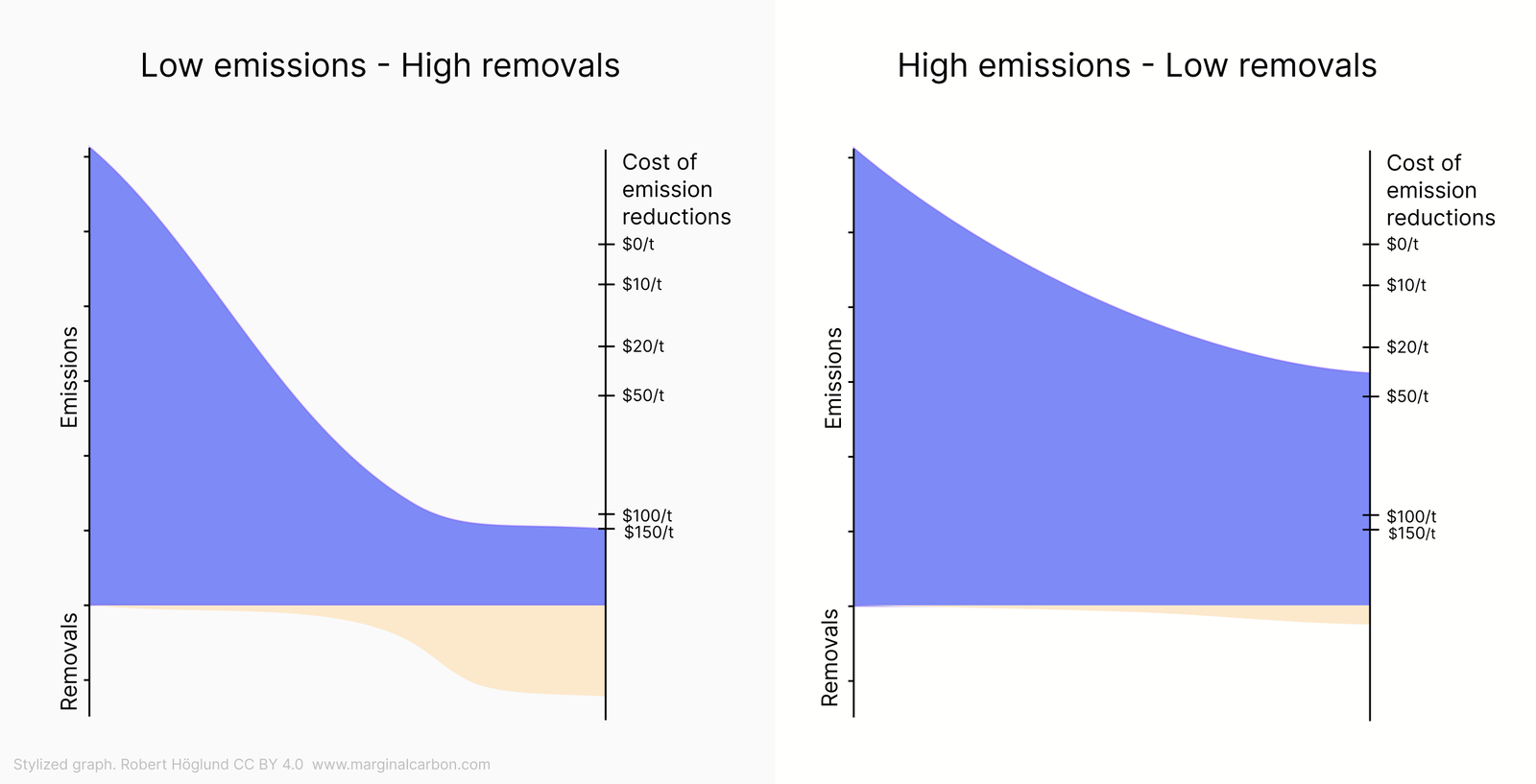The faster emissions are reduced, the more carbon will be removed


· 3 min read
How much carbon will we need to remove from the atmosphere? The answer is often determined by looking at how much emissions are expected to remain. For example, seeing that the world still emits 12 billion tons of CO₂e by 2050 in the IEA Announced Pledges Scenario, and drawing the conclusion that the slower emissions reductions are, the more carbon will be removed. But counterintuitively, the opposite is true.
What determines how much carbon is removed is the cost-effectiveness of using it. Since the vast majority of emission reductions are cheaper than carbon dioxide removal (CDR), these should be pursued first. Just because some emission reduction measures were not taken, it does not mean carbon removal is the better option. If emissions are reduced slowly, it means there still are a lot of cost-effective reduction opportunities left to pursue. The faster emissions are reduced, the sooner carbon removal becomes the cheapest mitigation option. Crucially, CDR is part of the mitigation toolbox but is often discussed as if it was outside it. This point has been emphasized by climate scientist Glen Peters several times.
What primarily will determine how much carbon is removed is its cost. Demand for durable and socially and environmentally sustainable CDR at <50 USD/t would likely be in the order of tens of billions of tons per year. While at 150 USD/t the demand might only be a couple of billion tons.

An important detail is that when making funding decisions today, we should look at the overall lifetime cost of a carbon removal method rather than just the cost of the initial deployments. If we project that direct air capture will be needed at a gigaton scale, and the price will drop quickly as it is deployed, then the price for the first few million tons removed is almost insignificant for the overall cost-effectiveness of the method.
The above analysis assumes that the most cost-effective will be deployed first. However, there is a big difference between what a global central planner would do and a real-world scenario where different actors make decisions based on their limited information and capabilities. In practice, more carbon will be removed than what is optimal in theory.
For example, a car-free individual living in an apartment might not have many investment opportunities to reduce their emissions, in which case carbon removal could be the best option. The same goes for many companies with most emissions in Scope 3. It can also apply to countries. In some cases, national policies to reduce emissions may be ineffective or very expensive per tonne CO₂ avoided, and carbon removal be the more efficient choice even if other actors in the world have cheaper mitigation options. In practice, it might be difficult to finance emission reductions elsewhere, and there have been grave issues with the additionality of such efforts in the past.
As demonstrated, the need for carbon removal in reaching net zero is determined by the cost of different mitigation options. But CDR might be needed not only to reach net zero, but also to bring temperatures back down. However, this will be a big undertaking. To reduce temperatures by 0.1C, about 222 billion tonnes of CO₂ would need to be removed from the atmosphere, costing trillions of dollars in even the most optimistic cost scenario. If that will be done is up to future generations to decide. What we need to focus on is reaching net zero as fast as possible, making the best possible use of all the methods in the mitigation toolbox.
This article is also published on the author's blog. illuminem Voices is a democratic space presenting the thoughts and opinions of leading Sustainability & Energy writers, their opinions do not necessarily represent those of illuminem.
illuminem briefings

Carbon Removal · Carbon
illuminem briefings

Carbon Removal · Net Zero
illuminem briefings

Biodiversity · Carbon Removal
Carbon Herald

Carbon Removal · Corporate Governance
ESG Today

Carbon Removal · Sustainable Finance
World Economic Forum

Carbon Removal · Sustainable Investment